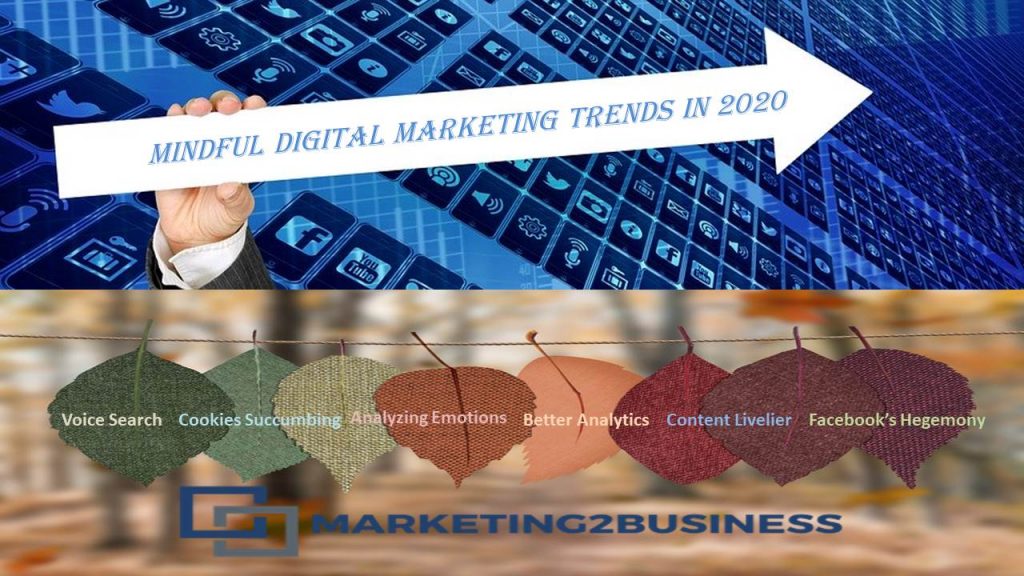The digital landscape is ever-evolving. New ideas and tools keep popping up at a dizzying speed that ends up confounding the marketers. Hence, for a successful digital marketing strategy, you must stay in the loop of emerging trends and tactics.

-
More Voice Search
Since the past few years, voice search has gained traction, and as per Andrew Ng, 50% of searches will be voice by 2020. With high-speed internet available on the go, customers are demanding more convenience to perform a search on the internet at the command of a few words.
Hence, it has become imperative to optimize for voice search. As voice search becomes popular, more solutions will emerge to convert those searches into sales.
We will see companies gradually migrating towards voice commerce. Google Shopping Actions is equipping retailers to sell with voice-enabled shopping on its platforms such as Google Assistant, Google.com, and Google Express.
-
Cookies Succumbing to Contextual Targeting
Since 2009, cookies had been a way to re-target customers. Wherever customers go on the web, they are bombarded with ads from a site they previously visited, making users paranoid here and there.
However, countries, including the US, have been introducing stricter privacy laws, making marketers scramble for alternate re-targeting options.
Hence, contextual targeting has emerged as the answer. It merely involves placing ads alongside relevant content. Marketers have the opportunity for more precise targeting by placing ads about things the customer is already actively looking for. Moreover, it also lets them do targeting on a granular level via relevant keywords, video metadata, titles, and descriptions, audio transcripts, and even comments within the content.
The cherry on top, with cookie-based targeting, a user could easily opt-out, but with contextual targeting, a website can share with a marketer what sort of content customers are looking for on their platform.
-
Analyzing Emotions in Real-time
AI and Machine Learning have made many things possible. One of them is understanding human emotions via Sentiment Analysis or Social Listening. It is the automated process of identifying users’ emotions and their reactions via text data, which is specifically acquired from social networks.
Companies utilize Sentiment Analysis to quickly and automatically analyze customers’ product reviews, social media comments, survey responses, and more to understand their customers’ perceptions. Then they improve upon the areas classifying as negative or neutral and capitalize on the positive.
However, that’s just the research part, bleeding-edge brands are attempting to deploy sentiment analysis in real-time. Macy’s On Call is a smartphone-based assistant that helps customers navigate the outlet, asking a series of questions and offering suggestions. If the AI-based assistant feels that a customer is getting frustrated, it alerts a nearby human assistant to handle the situation.
-
Going for Better Analytics
As of yet, 4.5 million companies are utilizing Google Analytics to measure their traffic, understand their audience, and optimize their site to deliver a remarkable user experience.
Analytics is a great free tool, but it is pretty rudimentary and not enough to factor in the latest paraphernalia such as voice search being infused into the website. In addition to that, we have repeat purchases, checkout bumps, upsell and down-sell. Moreover, new channels for revenue generation such as affiliate marketing, partnerships, online public relations, webinars, etc.
To better measure the copious amount of data originating from various channels and factors, companies are migrating towards platforms such as Google Data Studio, SAP, MicroStrategyor Amplitude. These business intelligence solutions gather all your data in one place and enable you to make well-informed decisions, which greatly influence the brand’s long-term value.
Jetson is a powerful voice-first marketplace, which lets your customer order from your site using voice search from anywhere. Moreover, it integrates well with Alexa, Google Assistant, and Slack. It strives to improve itself and customize the user experience by learning from each interaction.
-
Content is Becoming Livelier
91% of buyers want their content to be more interactive to help them make their purchasing decision. And by content, it doesn’t mean merely text. We are talking about AR/VR, 360-degree video, shoppable posts, fun social media quizzes, games or polls. Moreover, the audience wants videos — the most successful content format — to have interactive elements, which, in turn, boost engagement greatly.
Interactive content provides an original and extraordinary content experience rather than a mere curated blog post. In 2019, we saw interactive content being trickled into a brand’s digital marketing activities; however, from 2020 and so on, we will see brands come out with their guns blazing.
-
Facebook’s Hegemony is Being Challenged
For years, Facebook has dominated the attention of youngsters and old alike. However, alternative social media platforms popped up over the years to win audiences’ hearts just like Facebook did, but very few managed to achieve that since Facebook would attempt to smother any competition, just like it did with the purchase of Instagram and WhatsApp, emulation of Snapchat stories, etc.
Despite such aggressive undertakings, Snapchat, Twitter, Pinterest, Medium, Reddit, and the likes have managed to retain their popularity. Moreover, as per a study by Edison Research and Triton Digital, Facebook had around 15 million fewer U.S. users in 2019 than it did in 2017. The reason for that decline can pertain to Facebook’s continuous stay in hot waters after the 2016 election scandal.
It doesn’t mean that Facebook is in decline, but we are seeing the aforementioned alternative platforms becoming youngsters’ absolute favorite. This means marketers are also migrating to Snapchat, Instagram, Pinterest and other platforms to market their brand via appealing visuals.
What the Future Beholds?
The meaning of marketing has radically evolved over the ages, from merely a selling tool to providing value to customers. New trends and processes keep emerging to provide ultimate value and satisfaction to them.
Therefore, brands need to keep that goal in mind while marketing, and that means keeping pace with the latest trends and adapting them before the competition does.

